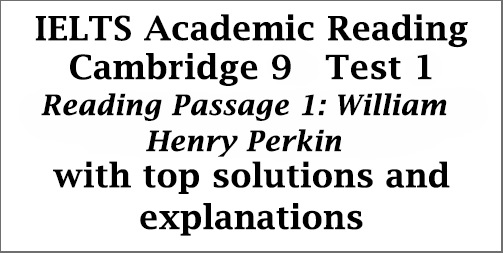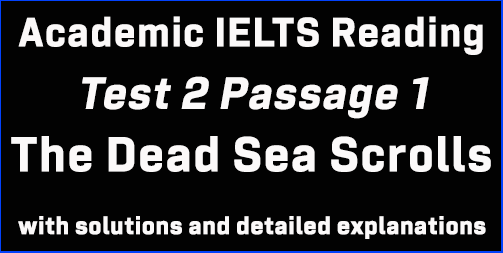IELTS Academic Reading: Cambridge 9, Test 1: Reading Passage 1; William Henry Perkin; with best solutions and detailed explanations
This IELTS Reading post focuses on all the solutions for IELTS Cambridge 9 Test 1 Reading Passage 1 which is entitled ‘William Henry Perkin’. This is an aimed post for candidates who have major problems in finding Reading Answers. This post can guide you the best to comprehend every Reading answer without much difficulty. Tracing IELTS Reading answers is a slow process and I sincerely hope this post can assist you in your IELTS Reading preparation.

IELTS Cambridge 9 Test 1: AC Reading Module
Reading Passage 1:
Title of the passage: William Henry Perkin
Questions 1-7: In this type of question, candidates are asked to find out whether:
The statement in the question agrees with the information in the passage – TRUE
The statement in the question contradicts the information in the passage – FALSE
If there is no information on this – NOT GIVEN
[For this type of question, you can divide each statement into three independent pieces and make your way through with the answer.]
Question 1: Michael Faraday was the first person to recognise Perkin’s ability as a student of chemistry.
Keywords for the question: Michael Faraday, first person, recognise, Perkin’s ability, student of chemistry,
Take a look at paragraph no. 2 where the writer mentions, “His talent and devotion to the subject were perceived by his teacher (at the City of London school) Thomas Hall….”.
This line suggests the fact that it was Thomas Hall, and not Michael Faraday, who first recognised the talent of Perkin in Chemistry. He also advised Perkin to attend the lectures given by Faraday.
So, the answer is: FALSE
Question 2: Michael Faraday suggested Perkin should enroll in the Royal College of Chemistry.
Keywords for the question: Michael Faraday, should enroll, Royal College of Chemistry
At the end of paragraph no. 2, we find the information that Perkin was able to enroll in the Royal College of Chemistry, but there is no mention of the person who suggested Perkin to admit in the college.
So, the answer is: NOT GIVEN
Question 3: Perkin employed August Wilhelm Hofmann as his assistant.
Keywords for the question: employed, Hofmann, assistant,
In paragraph no. 3, in lines 1-7, the writer mentions, ““At the time of Perkin’s enrolment, the Royal College of Chemistry was headed by the noted German chemist August Wilhelm Hofmann. Perkin’s scientific gifts soon caught Hofmann’s attention and, within two years, he became Hofmann’s youngest assistant.”
This means Perkin did not employ Hofmann, rather Hofmann employed Perkin as his assistant.
So, the answer is: FALSE
Question 4: Perkin was still young when he made the discovery that made him rich and famous.
Keywords for the question: still young, discovery, made him rich and famous,
Take a look at the end of paragraph no. 3. The writer says here, “Perkin’s scientific gifts soon caught Hofmann’s attention and, within two years, he became Hofmann’s youngest assistant. Not long after that, Perkin made the scientific breakthrough that would bring him both fame and fortune.”
Here, fame = famous, fortune = rich, scientific breakthrough = discovery,
So, these lines suggest that Perkin was still young when he made the discovery.
So, the answer is: TRUE
Question 5: The trees from which quinine is derived grow only in South America.
Keywords for the question: quinine, derived, grow, only in South America
Paragraph no. 4 talks about the medicine quinine and its tree which is ‘cinchona tree’ which originates in South America. But, there is no information which suggest that this tree only grows in this part of the world only.
So, the answer is: NOT GIVEN
Question 6: Perkin hoped to manufacture a drug from a coal tar waste product.
Keywords for the question: hoped, manufacture, drug, coal tar waste,
In paragraph no. 5, in lines 4-7, the author says, “.. . .. He (Perkin) was attempting to manufacture quinine from aniline, an inexpensive and readily available coal tar waste product.”
Here, attempted = hoped, quinine = a drug for the treatment of malaria.
So, the answer is: TRUE
Question 7: Perkin was inspired by the discoveries of the famous scientist Louis Pasteur.
Keywords for the question: inspired by, Louis Pasteur
At the end of paragraph no. 5 we find a quote from the world-famous scientist Louis Pasteur. But there is no mention of any inspiration received by Perkin from the discoveries of Louis Pasteur.
So, the answer is: NOT GIVEN
Questions 8-13: Short answer to open questions (NO MORE THAN TWO WORDS)
[In this kind of question candidates have to answer some questions, only with some conditions like NO MORE THAN THREE/TWO WORDS and/or A NUMBER or, ONE WORD ONLY. Each question has keywords that will lead to the answer. This question type generally follows a sequence.]
Question 8: Before Perkin’s discovery, with what group in society was the colour purple associated?
Keywords for the question: before, Perkin’s discovery, what group, purple associated,
In paragraph no. 6, the writer argues in lines 6-9, “Indeed, the purple colour extracted from a snail was once so costly that in society at the time, only the rich could afford it.”
The lines suggest that before the discovery made by Perkin, the colour purple was associated with the rich.
So, the answer is: the rich
Question 9: What potential did Perkin immediately understand that his new dye had?
Keywords for the question: potential, new dye, immediately understand,
At the end of paragraph no. 7, the writer states, “ .. . . But perhaps the most fascinating of all Perkin’s reactions to his find was his nearly instant recognition that the new dye had commercial possibilities.”
This means that Perkin immediately understood that his new dye had the potential of being sold commercially.
So, the answer is: commercial (possibilities)
Question 10: What was the name finally used to refer to the first colour Perkin invented?
Keywords for the question: finally, name, first colour
If we closely look at paragraph no. 7, we can find that the purple colour that Perkin discovered became the world’s first synthetic dye. Later, in the very beginning of paragraph no. 8, the writer mentions, “Perkin originally named his dye Tyrian Purple, but it later became commonly known as mauve.”
So, the final name of the purple colour was mauve.
So, the answer is: mauve
Question 11: What was the name of the person Perkin consulted before setting up his own dye works?
Keywords for the question: name, person, Perkin consulted,
In paragraph no. 8, we can find the name of the person with whom Perkin consulted about setting up his own dye works. “He (Perkin) asked advice of Scottish dye works owner Robert Pullar, who assured him that manufacturing the dye would be well worth it if the colour remained fast and the cost was relatively low.”
So, the answer is: Robert Pullar
Question 12: In what country did Perkin’s newly invented colour first become fashionable?
Keywords for the question: country, fashionable,
Take a close look at paragraph no. 9 where the writer says, “The company received a commercial boost from the Empress Eugénie of France, when she decided the new colour flattered her. Very soon, mauve was the necessary shade for all the fashionable ladies in that country.”
So, the answer is: France
Question 13: According to the passage, which disease is now being targeted by researchers using synthetic dyes?
Keywords for the question: disease, researchers, using synthetic dyes,
Take a look at the end of paragraph no. 10. “And, in what would have been particularly pleasing to Perkin, their current use is in the research for a vaccine against malaria.”
So, the answer is: malaria
Click here for solutions to Cambridge 9 Test 1 Reading Passage 2




I certainly love thoughts.
Yes
Good!
Thank you!
In answer 6 the answer would be false according to me because hoped means he just think that it would be happened but attempting to mean it already tried by him .
I have some doubt for question no 6 regarding hoped and attempted. I thought answer was false.in passage he attempted means tried but in question he hope means he is expect. Could you please clear my doubt
I have a question about no.1.
Why can we say “Thomas is the first person who found Perkin’s potential”?
I’m not native speaker, so I’m not sure that the word “perceive” has the meaning of recognizing for the “first time”.
Personally I think perceiving is similar to knowing, so it wouldn’t include the meaning of “ first “.
Does “perceive” have such meaning; recognize “ primarily “?
Sincerely.
Good method